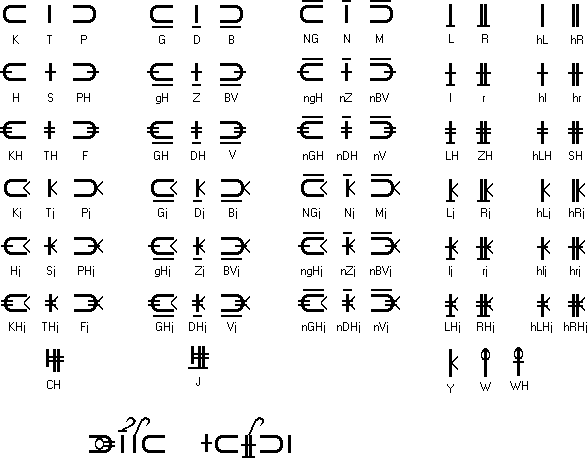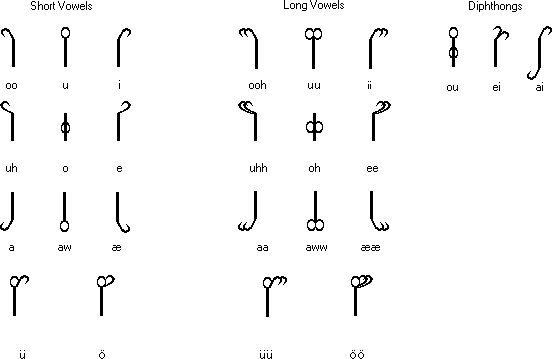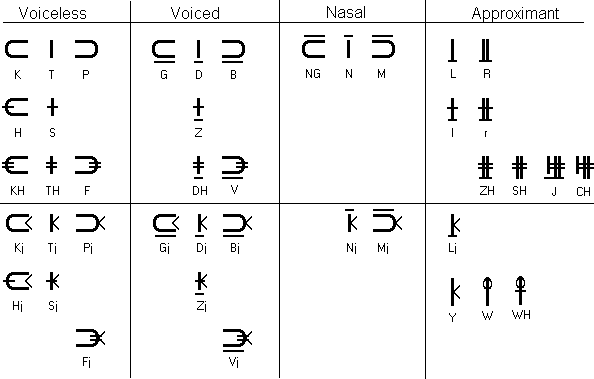 This phonetic script is a graphic representation of the sounds of speech
invented by Christian Crowley. The symbols are derived from the positions
of the organs of speech as they form various sounds, so related phones
have similar letter shapes. The letterforms represent the right profile
of the speaker.
This phonetic script is a graphic representation of the sounds of speech
invented by Christian Crowley. The symbols are derived from the positions
of the organs of speech as they form various sounds, so related phones
have similar letter shapes. The letterforms represent the right profile
of the speaker.
The three basic consonant shapes are taken from the three stops P, K and T. The sound P for example, has the lips together and the tongue flat. The sound K has the lips open and the back of the tongue touching the soft palate. The sound T is made with the front of the tongue raised, and is represented by a short vertical line.
Voicing is indicated by a line under the letterform, representing the generation of sound "below the mouth", by vibrating the vocal chords. Nasalization is indicated by a line over the letterform, representing the passage of air and sound "over the mouth", that is through the nose. Air escaping from the speaker's mouth is indicated by a horizontal line drawn through the letterform. Airflow accompanied by some friction or modification of the basic mouth position is represented by a double horizontal line.
The phones known as "approximants" fall somewhere between consonants and vowels: L, R, Y and W. Flapped L and R resemble D, which is reflected in the forms of these letters. Flapped L is like a D with a low mid-tongue, hence the lower stem on the L letterform. Trilled R is like a series of quick Ds, so the form resembles a doubled D. Flapped R is a trilled R with only one contact; no distinction is made between flapped and trilled R. A distinction is made between the "front" and "back" L, as in "light" and "hall". The "back" or "dark" L is made by drawing an L with an "open fricative" line. Likewise, a line through the flapped R indicates the American R. An R with the "closed fricative" double line indicates the ZH sound in "pleasure". Removing the voice-line from the bottom of this letter gives the voiceless SH, as in "shine".
A "palatization mark" can be added to any of these consonants to indicate that the sound is palatized, or that the middle of the tongue is raised toward the palate, as in "cute", "tune" and "pure". The letter form for the approximant Y derives from this palatization mark, as the Y sound is inherent in all palatized consonants. The letterform for Y is a vertical line that extends both higher and lower than that of T. This long riser is the "blank" letter used as a vowel holder, when a syllable starts with a vowel. This reflects the vowel-like quality of the approximant Y.
The last approximant, W, also has a vowel-like quality. This sound is characterized by the rounding of the lips, and the letter shape for W is a vowel holder combined with a round shape. Adding the open fricative line gives the voiceless, fricative counterpart of W: WH as in "why".
The form of the letter W serves as an introduction to the vowels. Pure vowels are characterized by where they are formed in the mouth: back or front; low, mid-range or high; and whether the lips are rounded or unrounded. W is similar in sound and shape to the rounded back vowels AW, O and U as in "paw", "lode" and "rude".
The vowel symbol is attached to the consonant it follows, or to the vowel holder if there is no preceding consonant. Low vowels are written below the consonant, high vowels above, and mid-range vowels go in the mid-line of writing.
The unrounded vowels are written as a swoop that curls toward the part of the mouth where the sound is formed. Back vowels A, UH and OO as in "car", "cup" and "good" have the swoop curling towards the left, or the back of the symbolic mouth formed by the consonant’s shape. Front vowels Æ, E and I as in "pad", "bed" and "miss" have the swoop curling towards the right, or the front of the symbolic mouth formed by the consonant’s shape. Long vowels and diphthongs are formed by combining two vowel markers into a single symbol.



the information and images on this page were put together by Christian Crowley (crow[at]gwu.edu)
Constructed scripts for: Ainu | Arabic | Chinese languages | Dutch | English | Hawaiian | Hungarian | Japanese | Korean | Lingala | Malay & Indonesian | Persian | Tagalog / Filipino | Russian | Sanskrit | Spanish | Taino | Turkish | Vietnamese | Welsh | Other natural languages | Colour-based scripts | Tactile scripts | Phonetic/universal scripts | Constructed scripts for constructed languages | Adaptations of existing alphabets | Fictional alphabets | Magical alphabets | A-Z index | How to submit a constructed script
[top]
You can support this site by Buying Me A Coffee, and if you like what you see on this page, you can use the buttons below to share it with people you know.

If you like this site and find it useful, you can support it by making a donation via PayPal or Patreon, or by contributing in other ways. Omniglot is how I make my living.
Note: all links on this site to Amazon.com, Amazon.co.uk
and Amazon.fr
are affiliate links. This means I earn a commission if you click on any of them and buy something. So by clicking on these links you can help to support this site.
[top]